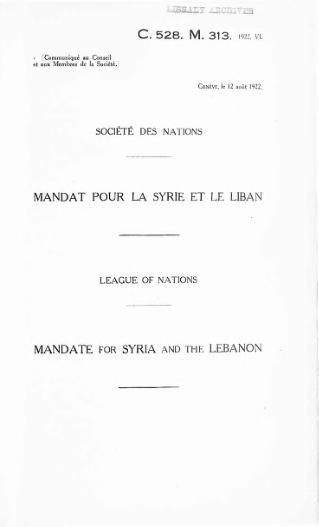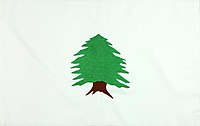
Lebanon, officially the Republic of Lebanon or the Lebanese Republic, is a country in Western Asia. It is located between Syria to the north and east and Israel to the south, while Cyprus lies to its west across the Mediterranean Sea; its location at the crossroads of the Mediterranean Basin and the Arabian hinterland has contributed to its rich history and shaped a cultural identity of religious diversity. It is part of the Levant region of the Middle East. Lebanon is home to roughly six million people and covers an area of 10,452 square kilometres (4,036 sq mi), making it the second smallest country in continental Asia. The official language of the state is Arabic, while French is also formally recognized; the Lebanese dialect of Arabic is used alongside Modern Standard Arabic throughout the country.

The history of Lebanon covers the history of the modern Republic of Lebanon and the earlier emergence of Greater Lebanon under the French Mandate for Syria and the Lebanon, as well as the previous history of the region, covered by the modern state.

Mount Lebanon is a mountain range in Lebanon. It averages above 2,500 m (8,200 ft) in elevation, with its peak at 3,088 m (10,131 ft).

Cedrus libani, the cedar of Lebanon or Lebanese cedar, is a species of tree in the genus cedrus, a part of the pine family, native to the mountains of the Eastern Mediterranean basin. It is a large evergreen conifer that has great religious and historical significance in the cultures of the Middle East, and is referenced many times in the literature of ancient civilisations. It is the national emblem of Lebanon and is widely used as an ornamental tree in parks and gardens.

The national flag of Lebanon is formed of two horizontal red stripes enveloping a horizontal white stripe. The white stripe is twice the height (width) of the red ones —a Spanish fess. The green cedar in the middle touches each of the red stripes and its width is one third of the width of the flag.

The Mandate for Syria and the Lebanon (1923−1946) was a League of Nations mandate founded in the aftermath of the First World War and the partitioning of the Ottoman Empire, concerning Syria and Lebanon. The mandate system was supposed to differ from colonialism, with the governing country intended to act as a trustee until the inhabitants were considered eligible for self-government. At that point, the mandate would terminate and an independent state would be born.

The State of Greater Lebanon, informally known as French Lebanon, was a state declared on 1 September 1920, which became the Lebanese Republic in May 1926, and is the predecessor of modern Lebanon.
The Constitution of Lebanon was adopted on 23 May 1926. Article 11, on the Official National Language, declares that "Arabic is the official national language. A law determines the cases in which the French language may be used."

Ehden is a mountainous city in the heart of the northern mountains of Lebanon and on the southwestern slopes of Mount Makmal in the Mount Lebanon Range. Its residents are the people of Zgharta, as it is within the Zgharta District.

Bsharri District is one of the 7 districts of the North Governorate, Lebanon.

Tobia Aoun was an Assistant to the Pontifical Throne, Archbishop of Beirut, Count of Rome, Bishop of Saint-John-Acre, Knight of the French Legion of Honour, Knight of the Ottoman Order of the Medjidie, and Council Father of the First Vatican Council.

Youssef Bey Karam, was a Lebanese Maronite notable for fighting in the 1860 civil war and led a rebellion in 1866–1867 against the Ottoman Empire rule in Mount Lebanon. His proclamations have been interpreted as an early expression of Lebanese nationalism.

The Cedars of God, located in the Kadisha Valley of Bsharre, Lebanon, are one of the last vestiges of the extensive forests of the Lebanon cedar that thrived across Mount Lebanon in antiquity. All early modern travelers' accounts of the wild cedars appear to refer to the ones in Bsharri; the Christian monks of the monasteries in the Kadisha Valley venerated the trees for centuries. The earliest documented references of the Cedars of God are found in Tablets 4-6 of the great Epic of Gilgamesh, six days walk from Uruk.

The Psalm 92, known as Mizmor Shir L'yom HaShabbat, is ostensibly dedicated to the Shabbat day. In the slightly different numbering system used in the Greek Septuagint and Latin Vulgate translations of the Bible, this psalm is Psalm 91.

The Ottoman Empire at least nominally ruled Mount Lebanon from its conquest in 1516 until the end of World War I in 1918.

Khazen (also El-Khazen, Al-Khazen, Khazin or De Khazen, Arabic: آل الخازن, is a prominent Levantine family and clan based in Keserwan District, Lebanon, Damascus, Syria, Nablus, Palestine, as well as other districts around the Levant, predominantly in the Galilee in Israel.

The Maronites are a Christian ethnoreligious group native to the Eastern Mediterranean and Levant region of the Middle East, whose members traditionally belong to the Maronite Church, with the largest concentration long residing near Mount Lebanon in modern Lebanon. The Maronite Church is an Eastern Catholic sui iuris particular church in full communion with the Pope and the rest of the Catholic Church, whose membership also includes non-ethnic Maronites.

The Mount Lebanon Mutasarrifate was one of the Ottoman Empire's subdivisions following the Tanzimat reform. After 1861, there existed an autonomous Mount Lebanon with a Christian mutasarrıf, which had been created as a homeland for the Maronites under European diplomatic pressure following the 1860 massacres. The Maronite Catholics and the Druze founded modern Lebanon in the early eighteenth century, through the ruling and social system known as the "Maronite-Druze dualism" in Mount Lebanon.

Psalm 29 is the 29th psalm of the Book of Psalms, beginning in English in the King James Version: "Give unto the LORD, O ye mighty, give unto the LORD glory and strength". The Book of Psalms is part of the third section of the Hebrew Bible, and a book of the Christian Old Testament. In the slightly different numbering system used in the Greek Septuagint and Latin Vulgate translations of the Bible, this psalm is Psalm 28. In Latin, it is known as "Adferte Domino filii Dei". The psalm is attributed to David. It is a hymn, describing the advent of Yahweh in a storm.

The Great Famine of Mount Lebanon (1915–1918) known in Syria as the "Turkish Famine", was a period of mass starvation during World War I that resulted in 200,000 deaths of largely Christian and Druze inhabitants.



















